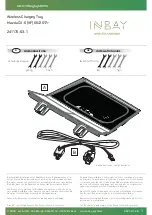
F3 Series Charger Manual
11
“FLOAT” (R34) and “BOOST” (R33), both located next to one of the control transformers.
4. Adjust the FLOAT pot until the desired voltage is achieved.
Adjustment of the BOOST voltage is similar to adjustment of FLOAT, except that you adjust the BOOST
pot instead of the FLOAT pot. Be sure that the charger front panel mode switch is in BOOST when you
make adjustments.
Please note that the BOOST adjustment controls the level above FLOAT voltage, not the absolute
voltage. Therefore, whenever the FLOAT the voltage is changed, the BOOST voltage also changes.
4.2
Factory-Set Output and Alarm Voltages
NOTE:
Output voltages are temperature compensated (vary with temperature). The factory settings
below are at 20 degrees C. The compensation is -0.18% per degree C. The alarm voltage settings are
NOT temperature compensated.
Chargers set for sealed maintenance-free lead-acid battery
12 volt
24 volt
32 volt
48 volt
120 volt
168 volts
240 volt
Float voltage
13.62
27.24
36.32
54.48
136.20
190.68
272.40
Boost voltage
13.80
27.60
36.80
55.20
138.00
193.20
276.00
Low DC alarm
11.00
22.00
29.33
44.00
110.00
154.00
220.00
High DC alarm
14.61
29.22
38.96
58.44
146.10
204.54
292.21
High DC shutdown
15.19
30.39
40.52
60.78
151.95
212.73
303.89
Chargers set for flooded lead-acid battery
12 volt
24 volt
32 volt
48 volt
120 volt
168 volts
240 volt
Float voltage
13.32
26.64
35.52
53.28
133.20
186.48
266.40
Boost voltage
14.00
28.00
37.28
55.92
139.80
196.00
279.60
Low DC alarm
11.00
22.00
29.33
44.00
110.00
154.00
220.00
High DC alarm
14.82
29.64
39.47
59.20
148.01
207.48
296.02
High DC shutdown
15.41
30.83
41.05
61.57
153.93
215.50
307.86
Chargers set for nickel cadmium battery Multiply volts per cell times # of cells for actual voltage
Per Cell
Float voltage
1.43
Boost voltage
1.52
Low DC alarm
1.19
High DC alarm
1.61
High DC shutdown
1.67
Chart 4.2 shows relationships between charger output voltage, alarms and high volt shutdown. Output
voltage is temperature compensated down to ten degrees C; compensation then ends.
To determine the charger’s voltage at temperatures other than 20 deg. C., multiply number of degrees C
difference between ambient and twenty C times .0018. Multiply that product times the factory voltage
setting (e.g. 27.24) and add it to the factory setting. Examples:
Example 1:
Float voltage at 10 degrees C of a 24 volt charger set for 27.24 volts at 20 degrees C:
20-10 (.0018) (27.24) + 27.24 =
27.73
volts
Example 2
: Float voltage at 50 degrees C of a 24 volt charger set for 27.24 volts at 20 degrees C:
20-50 (.0018) (27.24) + 27.24 =
25.77
volts






































